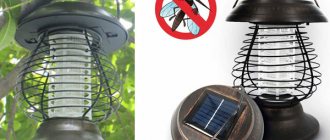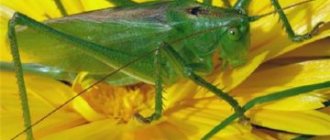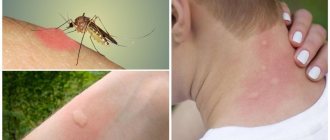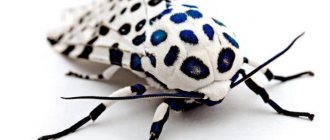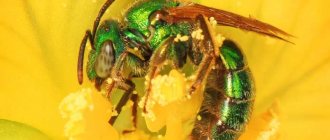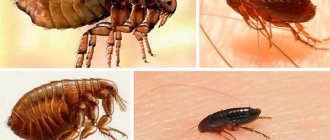Hexapods
Most insects, with all the variety of habits and sizes, have the same characteristics. So, in this case, to the question of how many legs insects have, the correct answer is “Six.” Three pairs of limbs are observed in ants and fleas, mantises and weevils, and in more than a billion species. True, the paws differ in structure, and in connection with this, oddly enough, in purpose. “How is it possible,” you will be surprised, “are the legs really intended not only for moving the body along the surface?” It turns out that this is true. Habitual concepts are undergoing significant changes; you just have to pay attention to the small (in size) inhabitants of the planet. They, as scientists say, mastered the earth long before mammals, have a serious organization that allows them to exist excellently and not pay attention to the “king of nature.”
How many types of insects are there in the world
Types of insects
Types of insects
Types of insects
Types of insects
Types of insects
Scientists have identified and described over 1 million species of insects, including over 17 thousand fossil species. Entomologists are still debating how many types of invertebrates actually exist on earth. Some claim that no more than 2-3 million, while others bring this figure to a massive 8. Every year about 7-8 thousand new species of individuals are discovered and described. All of them are usually assigned to one of more than 40 groups. Moreover, most of the insects known to us are included in one of the five considered the largest:
- Coleoptera. About 400 species. The forewings of representatives of this order have changed, turning into sclerotic or skin-covered elytra without veins. The lower wings are preserved and are used for flight. Basically these are beetles of various shapes and sizes.
- Diptera. Approximately 160.5 thousand species (about 4 thousand fossil species). Diptera include mosquitoes, midges, horse flies and true flies. Diptera live everywhere, including Antarctica.
- Lepidoptera. 160 thousand species. These are butterflies, moths, moths.
- Hymenoptera. 155 thousand species. Well known to everyone are wasps, bees, bumblebees, ants.
- Hemiptera. 105 thousand species. Bugs, water striders, aphids.
Many species have been poorly studied or not studied at all. This does not allow us to give them an accurate quantitative assessment.
What are the legs of insects?
The purpose of the limbs determines their name. Therefore, when you are asked: “How many legs do insects have?”, feel free to answer with the question: “Which ones?” And they are adjectives, running, digging and others. Usually only one pair of limbs is special. This is due to the lifestyle of a particular creature. For example, the front pair of the praying mantis is grasping. The locust or grasshopper is distinguished from its relatives by a pair of jumping limbs. They are immediately noticeable by their length and thickness. Cockroaches have running legs that are elongated. Digging limbs are observed in mole crickets. They are short and plump, strong. They usually dig with their front paws. Water lovers are the owners of swimming limbs. They are comfortable to row due to the hairs and flattened shins. How many walking legs do insects have in this case? The answer depends on the species. Unspecialized limbs are used for movement. They can be considered walking.
Main types of insects
About 15 types of different insects are found everywhere. These are bumblebees, butterflies, cockroaches, dragonflies, praying mantises, ants, chafers, grasshoppers, wasps, mosquitoes and others. Each invertebrate is unique and requires close study.
Bumblebee
Bumblebee
A winged, arthropod-like insect that undergoes a complete transformation as it matures from a worm-like entity into a beautiful insect covered in thick, wool-like hairs. Belongs to the bee family, bumblebee genus. The size depends on the gender - varies from 7 to 35 mm. The body is brown, with yellow accents. Bumblebees can collect nectar; nature has equipped them with special proboscis.
Firefly
Firefly
Coleopteran insect measuring from 4 mm to 3 cm. The body is flattened and covered with hairs. The firefly is capable of flying; it has 2 pairs of wings, one of which has turned into elytra. The head is large, the eyes are round, there are antennae, the oral apparatus is present only in larvae or females, males do not have it. The ability to glow in the dark also depends on gender.
Cockroach
Cockroach is
an arthropod insect whose body has an oval shape. Cockroaches come in different shapes, sizes and colors, the smallest barely reach 1 cm, the largest ones can grow up to 10 cm in length. The cockroach has 6 legs, wings and elytra, a well-developed mouth, as well as antennae that allow them to capture the slightest movements and vibrations of the air. Cockroaches feed on organic food.
Mantis
Praying Mantis
An insect with an elongated body, a mobile, almost triangular-shaped head and convex large compound eyes located on the sides. There are 3 more small eyes above the base of the antennae. The mouthparts are of a gnawing type, directed downwards. In this case, the pronotum almost never overlaps the head, which is a feature of insects of this type.
Midges
Midges
Midges belong to the order Diptera. They are distinguished by their small body size - from 1.2 to 6 mm. Small midges infest tropical forests; larger specimens live in the north, in temperate and subpolar latitudes. The midge's body is divided into three parts - head, abdomen and chest. The eyes are compounded, there are no additional simple ocelli. Life expectancy is several days or several weeks. Feeding is gender-linked, with females biting living creatures and males consuming plant nectar.
Chafer
May beetle
Some representatives of the May beetle variety reach a length of 30 cm or more. The body is wide, convex, its shape is elongated-oval. The color of the plates and wings is black or reddish brown. The insect is a winged insect and has a gnawing type of mouthparts. The beetle feeds on plants - it eats young shoots, flowers and ovaries of plants, as well as leaves.
Ant
Ant
A hymenopteran insect that has a social hierarchy. All ants in the anthill are divided into 3 castes - workers, females and males. There are about 13 thousand species of ants in the world, over 300 of them live in Russia and the post-Soviet space. These are black garden, red myrmica, small forest ant, pharaoh ant and others. The size of the body and its color depend on the habitat and belonging to a particular species. They feed on food of plant and animal origin.
Butterfly
Butterfly
A lepidopteran insect with a body covered with a chitinous membrane and well-defined wings. Scientists identify more than 158 thousand species. They live almost everywhere, with the exception of Antarctica. The most types of butterflies live in Peru and India. They feed on pollen and nectar of plants. But they can eat tree sap or rotting fruits. Sometimes butterflies steal honey from bee hives.
Bee
Bee
A social animal that, together with other members of its swarm, can build nests (hives), obtain nectar and process it into honey. The bee's body is covered with fluffy fibers, its wings are well developed, and it has a sting with which it extracts nectar. It is also used to protect against enemy attacks. Bees are distributed everywhere in huge numbers, but most of them are found where flowering plants are present.
Mosquito
Mosquito
A small blood-sucking insect that lives in almost all corners of the planet. Body length depends on the species and ranges from 4-17 mm. The wings and body of the mosquito are in most cases gray or brown, but there are orange, yellow, green and even red species. To obtain food, the animal uses a thin but long proboscis.
Wasp
Wasp
Hymenoptera arthropod insect. The body is medium in size (1.5-10 cm), painted in black and white stripes, which have long been the calling card of the wasp. The wasp is found everywhere except the Arabian Peninsula, the Arctic and the Sahara. Some species of this insect are herbivores, but there are also predators among them.
Interesting fact : wasps are so numerous on planet Earth that certain species belong to different families.
Grasshopper
Grasshopper
New-winged insect from the grasshopper superfamily. The body length of individual representatives of the species is 1.5-15 cm. The color depends on the habitat, but the wings and body of most herbivorous representatives of the species are green. The grasshopper is not a pest, except for those members of the family that feed on citrus fruits.
Fly
Fly
A two-winged arthropod insect, the size of which depends on its belonging to a specific species. There are very small flies, 10-15 mm long, and giant flies, whose body dimensions are at least 2 cm. The wings are membranous, the head is round, and can make buzzing sounds in flight. Some types of flies are carriers of various diseases.
Dragonfly
Dragonfly
A winged insect with six legs. The dragonfly has a slender body, a large head and a streamlined chest, and beautiful transparent wings. Interestingly, the head is connected to the body in such a way that the creature can rotate it 180 degrees. It brings great benefits by destroying insects that are undesirable for humans. Thus, dragonflies living in Europe feed on mosquitoes, and those living in Africa feed on the Tsetse fly, which is harmful to people and livestock.
Ladybug
Ladybug
Coleopteran insect, ranging in size from 4 to 10 mm. The body color is red with black speckles on the wings. The exact origin of the name is unknown. It is found everywhere, lives a long time (6 months), but after the female fulfills her duty to future generations (laying eggs), her existence ceases. The ladybug is useful to humans and plants; it feeds on aphids, destroying up to 100 individuals of this pest per day.
Limb structure
Despite the variety of types, all legs are created almost identically. They consist of five departments. The magnifying glass is attached to the chest by a basin. Then comes the vetluga, thigh, and shin. The leg ends with a paw. Such a complex structure ensures the speed and maneuverability of the insect. Any limb ends in a claw. Specialized legs may be underdeveloped - then they lack some elements. Regardless of the degree of development, the number of legs in insects includes all limbs. The structure of the legs is not limited to the described elements. Each of them is divided into subsections and has options. So, for example, the foot can consist of several (up to five) segments. Such difficulties lead to the fact that sometimes only scientists can reliably tell how many legs insects have. Below is an interesting example.
How are the limbs of insects arranged?
The class insects belongs to the phylum arthropods. This name confirms the structural features of the legs of insects: they consist of several segments.
The main segment attached to the corresponding segment of the chest is called the coxa. The basin has a strictly defined shape. It differs among different types of insects. In some representatives the coxa looks like a ball or transverse cylinder, in others it looks like a cone or a wide leaf. The mobility of the limb depends on the shape of the coxa. The smallest segment is called the trochanter. Sometimes it is double. The trochanter is motionlessly articulated with the femur.
The longest component of the limb is the femur. It is longer than all parts of the leg and looks like a long cylindrical stick.
The next section is called the lower leg. It is comparable in size to the thigh, and together with it makes up the longest part of the insect’s limb.
The thigh and lower leg are connected using the knee. The leg ends with a paw. It consists of several flaxes movably connected to each other, their number is 2 - 5. The foot is armed with small claws. Usually there are two, and extremely rarely one.
Even insects that fly or swim need legs.
Bee
Everyone knows this hard work. It flies, pollinates flowers, collects honey... How many pairs of legs does an insect have, and are all of its limbs like this? It turns out that the bee has special baskets on its forelimbs into which it places pollen. On the very last segment, the tarsus, there are fibers called brushes. With them the bee collects a valuable product. If you look closely, it turns out that the front pair are almost arms with a very complex structure. But scientists do not recognize this fact. These limbs belong to the legs and are called collective limbs. Let's count the number of walking legs in bee insects. If two legs are devoted to collecting operations, then the insect moves with the rest. This means that she has two pairs of walking legs. This is basically how the calculation is done, but not for everyone.
Why gears?
While studying the number of legs in insects of different classes, their structure and functions, scientists came across an unexpected fact. Some of them have an interesting mechanism in their structure - a gear. Schematically, it can be represented in the form of two jagged wheels that are interlocked. Through the protrusions they interact and synchronize movement. Why is this? It turns out that this mechanism allows insects to jump at tremendous speed. This miracle lives in America, it is called Jesus. It is not capable of flight, but it makes amazing jumps. Even a speeding car will not be able to overtake it during takeoff. It is interesting that these legs are located not on the sides, but at the bottom of the insect. This makes his life problematic. If you do not push off synchronously, then the jump will not work. The insect simply circles on one leg. Evolution has eliminated this effect with a mechanical device whose purpose is to make the shocks synchronous. The scientists' surprise knew no bounds. This is the first recorded fact of the use of engineering in the structure of living beings.
Many people are confused about the types of invertebrates when answering the question of how many pairs of legs insects have. Spiders and centipedes of all kinds are mistakenly included among them, which is fundamentally incorrect. Later we will say a few words about them, but for now we will turn our attention to representatives of the Insect class.
How are limbs constructed?
The fact that insects belong to the class arthropods is confirmed by the structural features of the legs. They consist of several segments. The main segment is the coxa, which is attached to the corresponding segment of the chest and has a certain shape. Different types of insects have different shapes. In some, this segment looks like a transverse cylinder or ball, in others, the coxa looks like a wide leaf or cone. The mobility of the limb directly depends on the shape of the coxa.
The smallest segment, motionlessly articulated with the thigh, is called the trochanter. In some bugs it is double.
The thigh is connected to the lower leg by the knee, the leg ends with a paw with small claws. The paw consists of several (2-5) flaxes that are connected to each other.
Scientists, studying the number of limbs in insects of various classes, unexpectedly came across the fact that some of their representatives have an interesting mechanism in their structure - a gear. It can be represented schematically in the form of two interlocking wheels with notches. These wheels, through protrusions, interact and synchronize movement. This mechanism allows insects to jump at tremendous speed.
Cicada
The world of insects also has its own record holders. Thus, the structure of the limbs of the penny cicada allows it to jump to incredible heights, given its small size. If we draw an analogy with a person, we get two hundred and ten meters. It is clear that this insect has a pair of jumping limbs, very strong and fast. They act like a catapult, powerfully sending the body upward. In this case, the acceleration reaches four thousand meters per second. And in order not to slide off the plants on which the insect feeds, its front legs are equipped with sharp spines.
How do insects overwinter?
Insects spend the cold season in different ways. Some, like birds, fly south. This is what some species of butterflies and dragonflies do, covering significant distances together with birds and rising to incredible heights (over 5 km).
Others fall into numbness and hibernation. They climb deep into the earth, hide under the roots of plants, under fallen leaves and trees, stop consuming food and lose mobility. Ants overwinter on the lower floors of the anthill, often located at a depth of about 1 meter.
Naturally, not all species overwinter; representatives of many simply do not survive winter: their life is so short that they are not even aware of the cold.
In the spring, the suspended animation into which the surviving insects fell ceases, and butterflies, beetles, and dragonflies are born along with the first rays of the spring sun.
Water bugs
All aquatic insects are of interest from the point of view of the structure of their limbs. They demonstrate a completely different, but also unique adaptation. Science has asked how they can float on the surface of the water and not drown? It turned out that the water beetle has a kind of oar on its hind legs. Special hairs have grown on them, with which the insect makes rowing movements. This is how it floats on water. Some species are equipped with thickened and widened segments (this is the last section of the leg). Thanks to this structure, they can float perfectly on the water. Although these insects prefer to live in calm waters. It is difficult for them to fight against strong currents. The little creature does not have enough strength for this.
Dragonfly and others
Another amazing representative of the insect world. This flyer uses her limbs in a special way. Her legs are equipped with stiff bristles. When a dragonfly flies, it arranges its limbs in such a way that it forms a kind of net. With this device she gets her food!
Small insects, caught in the interweaving of bristles, immediately become prey and are eaten by the dragonfly. The variety of ways and methods of using insect legs is truly enormous. They are not only designed for walking, like mammals. They are used to row, and cut, and grab. Insects also use their legs to clean their antennae. For this purpose, the limbs are equipped with special grooves. But some species of butterflies use their front legs exclusively for rubbing their eyes. These limbs are atrophied and equipped with special hairs.
Communication
Cicadas are known for their singing.
Insects communicate with each other using sounds, light and contact signals and pheromones:
- Sounds. Many insects are able to produce and detect sound signals. This allows them to navigate in space, find representatives of their species for mating, and even scare off enemies. Sounds are produced by systematic impacts of different parts of the body on the substrate. But, for example, cicadas have timbal membranes that help them produce high-pitched calls that resemble screams. Grasshoppers, crickets and mole crickets rub their wing covers against each other. The result is a chirping sound.
- Contact signal. Characteristic of well-organized social insects, such as bees. Having discovered a source of food, the scout bee begins to perform something like a dance, luring its companions in this simple way. Ants use antennas on their heads to transmit signals.
- Glow. Most Coleopteran insects glow in the dark. They use light signals to search for food or call a partner. At the same time, the light does not have to be white or yellow; some fireflies alternately emit light of red and green shades.
Pheromones are used for the sole purpose of attracting individuals of the opposite sex. But some insects can emit certain odors when a predator approaches, scaring them away and driving them away.
Interesting: Why do bees make more honey than they need?
What about centipedes and spiders?
Contrary to popular belief, and even to the name, the centipede has not forty legs, but only thirty. By the way, they appear in an extremely interesting way in an invertebrate. At the beginning of its existence, it has only eight legs (almost a spider). Then the centipede begins to grow, the body lengthens, and additional limbs gradually grow. It turns out that the question of the number of legs of a centipede is closely related to its life expectancy.
And this creature treats its limbs very carelessly. As soon as it senses a threat, for example, a paw is stuck to the web, without thinking twice, they simply get rid of it. We can say that this is a kind of defense mechanism. Very convenient, isn't it? Especially considering that the centipede is capable of regenerating limbs.
Spider... Strange as it may sound, this representative of the animal world is not an insect. It has eight legs, not six, like insects, and the body consists of only two parts (the cephalothorax and the abdomen). In most cases, all spiders are predators, while insects mostly feed on vegetation.


